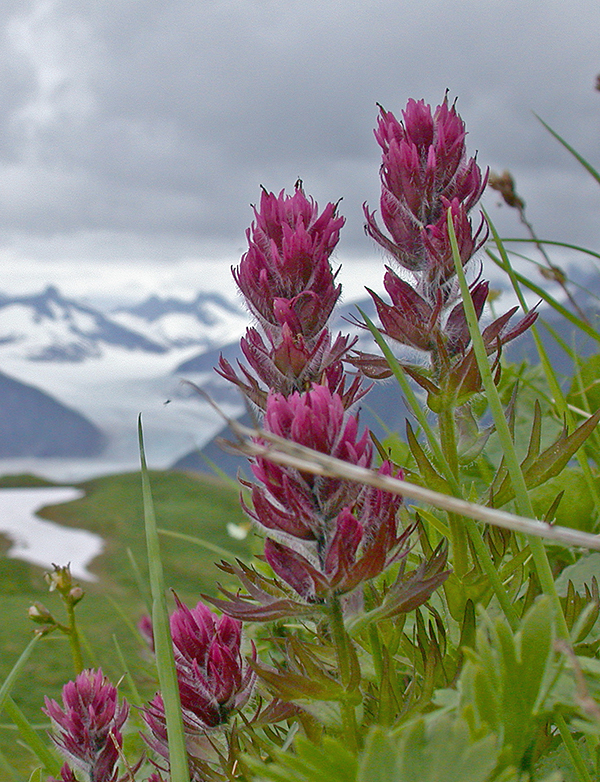When we think of parasites, we usually think of tapeworms, ticks, fungi, and assorted micro-organisms. But the world of flowering plants provides some interesting examples of a botanical version of parasitism, in which one plant extracts nutrients from another. We have two quite conspicuous and common kinds of flowering-plant parasites: hemlock dwarf mistletoe (Arceuthobium campylopodium) and northern ground cone (with the resounding name of Boschniakia rossica). Both of these species are entirely parasitic (or almost so). They derive all or almost all of their nutrients from their host plants and are unable to survive without a host.
You may have noticed the ‘witches brooms’ of gnarly, tangled branches that are the result of a mistletoe infection. The mistletoe alters the balance of growth hormones in hemlocks (and sometimes other species), causing the ‘brooms’. Male and female mistletoe plants are separate, with very small, inconspicuous flowers. Pollination is mostly by wind. When the seeds mature, they are discharged explosively; they are capable of travelling ten yards or more. Because they are sticky, they adhere to other branches or trunks and start new infections. This species has been reasonably well studied, because heavy infestations decrease the economic value of the timber.
The ground cone pokes up above ground in June. All we see is the cone-like inflorescence of tightly packed, brownish flowers; the rest of the plant is underground. Ground cone is commonly parasitic on the roots of alders, and sometimes other species, including blueberries. Various insects may visit the flowers and accomplish pollination; occasionally we have seen bumblebees probing the flowers. The seeds are minute and very numerous. The biology of this species apparently has not been studied in detail, as I can find no scientific papers on the subject, but the medicinal uses of this plant are reported to be many. We do know, from local observations, that bears frequently dig up and eat the underground base of the flowering stalk.
In addition, all orchids depend on their mycorrhizae (fungal associates) at least at some time in their life history. Some researchers consider the relationship to be mutualistic, with both participants gaining some advantages, and that eventually may be the case when the adult orchid develops green leaves and can provide carbohydrates to the fungus in return for soil nutrients. However, other researchers refer to mycorrhizal associations as a parasitism by the orchids on the fungi. This seems especially applicable in the case of orchids that develop little or no green tissue as they mature, so they can contribute nothing to their fungal associates. We have two species of the genus Corallorhiza (coralroot), one of which has no green tissue at all, while the other has a little and so can make some carbohydrates. They are both parasitic on fungi for all of their lifespans, but the relationships are even more complex: they can indirectly parasitize green plants through their fungi, which attach to the roots of trees and shrubs (which have their own mycorrhizae), and draw nutrients from those hosts.
Less well known are the so-called hemi-parasites, half parasitic and half independent. They have chlorophyll and can synthesize carbohydrates, but also commonly latch on to other plants and capture some nutrients from these hosts. We have a number of hemi-parasites among our local flowers.
The plant called yellow rattle or rattle box (Rhinanthus minor) grows in open areas at low elevations. This species is capable of parasitizing the roots of many other herbaceous species, including grasses. A single Rhinanthus plant can attach itself to the roots of several other plants. Some plants, however, are able to resist invasion by the roots of the parasite. Rhinanthus plants clearly benefit from the parasitic connections, growing and reproducing better if they are connected to a host. Some hosts, such as legumes, are better than others in providing the parasite with nutrients. In addition, the parasite can take up defensive chemicals, such as alkaloids, from the host, and thus reduce the risk of herbivory. The effects on the host plants are negative, because many of their nutrients are drained away by the parasite; parasitized hosts have decreased growth and reproduction; the negative impact is greater in some hosts than in others. There are indirect effects of Rhinanthus parasitism too: parasitized hosts have lower ability to compete with other plants in the community, and lower ability to recover from herbivory, which then affects the relative abundance of various species in the entire community.

There are three species of Indian paintbrush (Castilleja) in Southeast, but only one has been studied much, and those studies were conducted elsewhere. In general, members of this genus grow better, flower more, and resist herbivory better, when they are connected to a host plant. Legumes seem to be better hosts than other plants, and two or more hosts may be better than one. When a parasitic paintbrush plant dies and decays, decomposition is accelerated, and co-occurring species have increased productivity, which may counter the usual negative effects of the parasite to some degree.
The genus Pedicularis—the louseworts–has about five representatives in our area, which have not been studied directly, as far as I can tell. In general, the negative effects of parasitism by different species of lousewort may vary among host species, and different louseworts have different host preferences. Some louseworts are reported to have mycorrhizal associations too, collecting nutrients via the fungal connection in addition to the usual direct parasitism.
Clearly, the world of the parasitic flowering plants is complicated, and it gets more complex as more studies are conducted. All those pretty (and not so pretty) flowers are intricately involved with many ecological interactions, and what we see above-ground is only a small part of the story.
